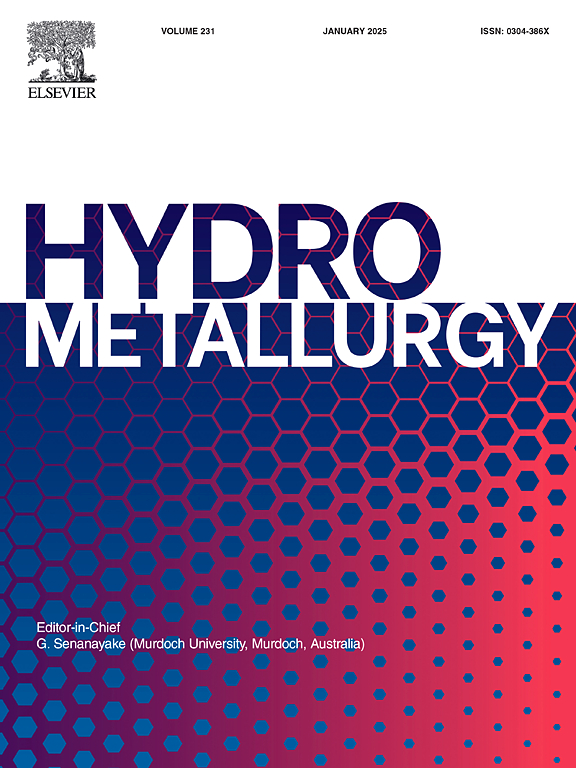利用基于剪切增强络合的旋转圆盘膜超滤分离工艺废水中重稀土元素的Dy(III), Yb(III)和Y(III):实验室研究和DFT计算
IF 4.8
2区 材料科学
Q1 METALLURGY & METALLURGICAL ENGINEERING
引用次数: 0
摘要
从废水中有效分离和回收重稀土元素是一个重大挑战。以酸性磷酸壳聚糖(aPCS)为络合剂,采用剪切诱导解离-超滤技术,成功地实现了废水中Dy(III)、Yb(III)和Y(III)的分离和回收。与依赖有机溶剂的传统方法不同,该过程不需要额外的化学品,增强了环境的可持续性。确定了aPCS-RE络合物的临界剪切速率,并计算出βY/Dy、βY/Yb和βDy/Yb的分离系数分别为15.8、21.1和14.8。剪切效应显著提高了膜通量,减轻了污染,与传统过滤技术相比具有显著的优势。DFT计算表明,aPCS与稀土金属离子的相互作用主要是离子型的,电荷转移是影响aPCS- re配合物稳定性差异的重要因素。本文章由计算机程序翻译,如有差异,请以英文原文为准。

Separation of Dy(III), Yb(III) and Y(III) by ultrafiltration using a rotating disk membrane based on shear-enhanced complexation to recover heavy rare earth elements in process wastewater: Laboratory studies and DFT calculations
The effective separation and recovery of heavy rare earth elements from wastewater presents a significant challenge. This work successfully achieved the separation and recovery of Dy(III), Yb(III), and Y(III) from wastewater using shear-induced dissociation-ultrafiltration technology with acidic phosphoric chitosan (aPCS) as the complexing agent. Unlike traditional methods that depend on organic solvents, this process requires no additional chemicals, enhancing environmental sustainability. The critical shear rates for de-complexation of aPCS-RE complexes were identified, and the separation coefficients βY/Dy, βY/Yb, and βDy/Yb were calculated as 15.8, 21.1, and 14.8, respectively. The shear effect significantly enhanced membrane flux and mitigated fouling, representing a notable advantage over conventional filtration techniques. Additionally, DFT calculations revealed that the interactions of aPCS with rare earth metal ions were mainly ionic and that charge transfer played an important role in the stability difference of aPCS-RE complexes.
求助全文
通过发布文献求助,成功后即可免费获取论文全文。
去求助
来源期刊

Hydrometallurgy
工程技术-冶金工程
CiteScore
9.50
自引率
6.40%
发文量
144
审稿时长
3.4 months
期刊介绍:
Hydrometallurgy aims to compile studies on novel processes, process design, chemistry, modelling, control, economics and interfaces between unit operations, and to provide a forum for discussions on case histories and operational difficulties.
Topics covered include: leaching of metal values by chemical reagents or bacterial action at ambient or elevated pressures and temperatures; separation of solids from leach liquors; removal of impurities and recovery of metal values by precipitation, ion exchange, solvent extraction, gaseous reduction, cementation, electro-winning and electro-refining; pre-treatment of ores by roasting or chemical treatments such as halogenation or reduction; recycling of reagents and treatment of effluents.
 求助内容:
求助内容: 应助结果提醒方式:
应助结果提醒方式:


